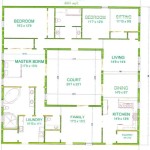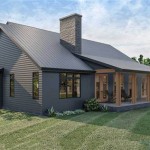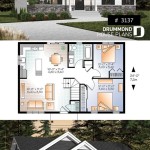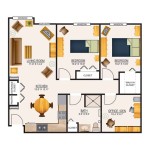Design Your Own House Floor Plans: A Comprehensive Guide
Designing a house floor plan is a significant undertaking, whether embarking on a new construction project or planning a major renovation. A well-designed floor plan is not merely an aesthetic consideration; it’s the foundation of a comfortable, functional, and efficient living space. It directly impacts how occupants interact with the house, how light and ventilation circulate, and ultimately, the overall quality of life experienced within the home.
While engaging an architect or professional designer is often recommended, particularly for complex projects, understanding the fundamentals of floor plan design empowers individuals to make informed decisions, communicate their needs effectively to professionals, and even create preliminary designs independently. This article provides a comprehensive overview of the key considerations and steps involved in designing your own house floor plans, equipping you with the knowledge to embark on this exciting endeavor.
Understanding Your Needs and Lifestyle
The first and arguably most crucial step in designing a floor plan is a thorough assessment of personal needs and lifestyle. This involves a critical evaluation of current living habits, future aspirations, and any specific requirements or limitations that need to be addressed. This stage lays the groundwork for a floor plan that truly caters to the unique needs of the occupants.
Start by considering the number of occupants. This directly impacts the number of bedrooms and bathrooms required. Factor in potential future growth, such as the possibility of expanding the family or accommodating aging parents. Consider the age and mobility of each occupant. Are there any accessibility needs, such as wider doorways or ramps, that need to be incorporated into the design?
Next, analyze your daily routines and how the house will be used. How much time is spent in the kitchen? Is it a space for cooking elaborate meals or primarily for quick breakfasts? Do you entertain frequently? This will influence the size and layout of the kitchen and dining areas. Consider the need for a home office, a dedicated workout space, or a hobby room. Identify areas prone to congestion and areas that require quiet contemplation. Consider the importance of privacy for different family members and how the floor plan can facilitate this.
Think about storage needs. Adequate storage is essential for maintaining a clutter-free and organized living space. Consider storage requirements for clothing, appliances, holiday decorations, and outdoor equipment. Plan for walk-in closets, pantry space, shelving units, and garage storage.
Finally, consider your aesthetic preferences and design style. Are you drawn to open-concept living, or do you prefer more traditional, compartmentalized spaces? Do you prefer a minimalist aesthetic, or do you favor a more ornate style? Browsing through magazines, online design platforms, and visiting open houses can provide inspiration and help you refine your design preferences.
Key Principles of Effective Floor Plan Design
Once a thorough understanding of needs and lifestyle is established, the next step is to apply fundamental design principles to create a functional and aesthetically pleasing floor plan. These principles guide the layout and organization of spaces, ensuring a comfortable and efficient living environment.
Circulation: Circulation refers to the flow of movement within the house. A well-designed floor plan minimizes unnecessary walking distances and avoids creating bottlenecks. Pathways should be clear and unobstructed, allowing for easy navigation between different areas of the house. Consider the typical routes taken throughout the day and ensure that these routes are as direct and efficient as possible.
Zoning: Zoning involves separating different areas of the house based on their function. This helps to create defined spaces and minimize noise and disruption. Typically, a house is divided into three main zones: a public zone (living room, dining room, kitchen), a private zone (bedrooms, bathrooms), and a service zone (laundry room, garage). Strategically zoning these areas ensures privacy and minimizes disturbances between different activities.
Natural Light and Ventilation: Natural light and ventilation are essential for creating a healthy and comfortable living environment. Maximize the use of natural light by strategically placing windows and skylights. Consider the orientation of the house and how it will affect the amount of sunlight received in different rooms. Ensure adequate ventilation by providing windows that can be opened in each room. Consider the prevailing winds and how they can be used to naturally cool the house.
Room Dimensions and Proportions: The size and shape of rooms should be carefully considered to ensure they are both functional and aesthetically pleasing. Avoid creating rooms that are too small or too large. The proportions of a room should be balanced and harmonious. Consider the furniture that will be placed in each room and ensure that there is enough space for comfortable movement. A standard rule of thumb is to maintain a minimum of 3 feet of clearance around furniture pieces.
Placement of Doors and Windows: The placement of doors and windows significantly impacts the flow of movement, the amount of natural light, and the overall aesthetic of the house. Doors should be strategically placed to avoid disrupting circulation and to provide privacy. Windows should be positioned to maximize natural light and ventilation while also offering views of the surrounding landscape.
Tools and Techniques for Creating Floor Plans
With a clear understanding of needs, lifestyle, and design principles, it's time to translate those concepts into a tangible floor plan. Several tools and techniques can be employed, each offering different levels of complexity and precision.
Sketching: Sketching is a valuable preliminary step to explore different layout options and refine design ideas. Start by sketching rough diagrams of each room, experimenting with different arrangements of furniture and fixtures. Don't be afraid to make mistakes and try different approaches. Sketching allows for quick and easy exploration of different possibilities before committing to a more detailed design.
Graph Paper: Graph paper provides a structured framework for creating more precise floor plans. Using a specific scale (e.g., 1/4 inch = 1 foot), you can accurately represent the dimensions of rooms and furniture. This allows for a more realistic assessment of space and helps to identify potential problems early on. Graph paper is a simple and inexpensive tool that can be used to create detailed and accurate floor plans.
Online Floor Plan Software: Numerous online floor plan software programs are available, ranging from free to subscription-based options. These programs offer a user-friendly interface and a vast library of pre-designed furniture and fixtures. They allow you to easily create and modify floor plans, visualize the space in 3D, and even generate realistic renderings. Online floor plan software can significantly streamline the design process and help you create professional-looking floor plans.
Computer-Aided Design (CAD) Software: CAD software, such as AutoCAD or Revit, offers the most advanced capabilities for creating detailed and accurate floor plans. These programs allow you to create precise drawings, generate 3D models, and even simulate building performance. CAD software is typically used by architects and professional designers, but it can also be used by homeowners who are comfortable with more technical software.
When using any of these tools, remember to adhere to the adopted scale consistently. Accurately representing wall thicknesses and door/window dimensions is critical for a realistic depiction of the space. Consider the placement of electrical outlets, lighting fixtures, and plumbing fixtures during the planning stage to avoid costly revisions later.
Regardless of the method chosen, ensure the plan adheres to local building codes and regulations. These codes dictate minimum room sizes, egress requirements, and other safety-related aspects of the design. Consulting with a local building inspector or contractor is highly recommended to ensure compliance.
Iterate and refine the design. Few initial floor plans are perfect. Review the plan critically, considering all aspects discussed above. Identify areas that could be improved and make necessary adjustments. Share the plan with family members or friends and solicit their feedback. The design process is iterative; continuous refinement will result in a better final product.

House Plans How To Design Your Home Plan

House Plans How To Design Your Home Plan

Design Your Own Home House Designing Homes

House Plans How To Design Your Home Plan

Creating Your Dream Custom Floor Plan Citadel Signature Homes

Choosing The Best Floor Plan For Your Modular Home Next

Floor Plans Learn How To Design And Plan

From Sketch To Reality How Design A House You Ll Love

Custom Home Designs Design Your Dream Pulte

Customize Your Floor Plan Diyanni Homes








